

ISSUES TODAY
ISSUES
TODAY

By June 1992, the House of Sharing was founded through the funds raised by Buddhist organizations and various socio-civic groups. It’s a nursing home for living in “comfort women” in Seoul, South Korea. The House of Sharing including “The Museum of Sexual Slavery by Japanese Military” to spread the truth and educate descendants and the public.
Statue of Peace also known as Sonyeosang “Statue of Girl” or Comfort Women Statue. The statue was erected to call for apology and remembrance. The idea of this statue was proposed by the Korean Council for Women Drafted for Military Sexual Slavery by Japan. Kim Seo-kyung and Kim Eun-sung designed the statue. The statue depicts a girl dressed in a Chima Jeogori, a modified form of hanbok in the late 19th-early 20th century, with small hands and short hair, and staring at the Embassy of Japan in Central Seoul. Each part of the statue was has a symbolic meaning.
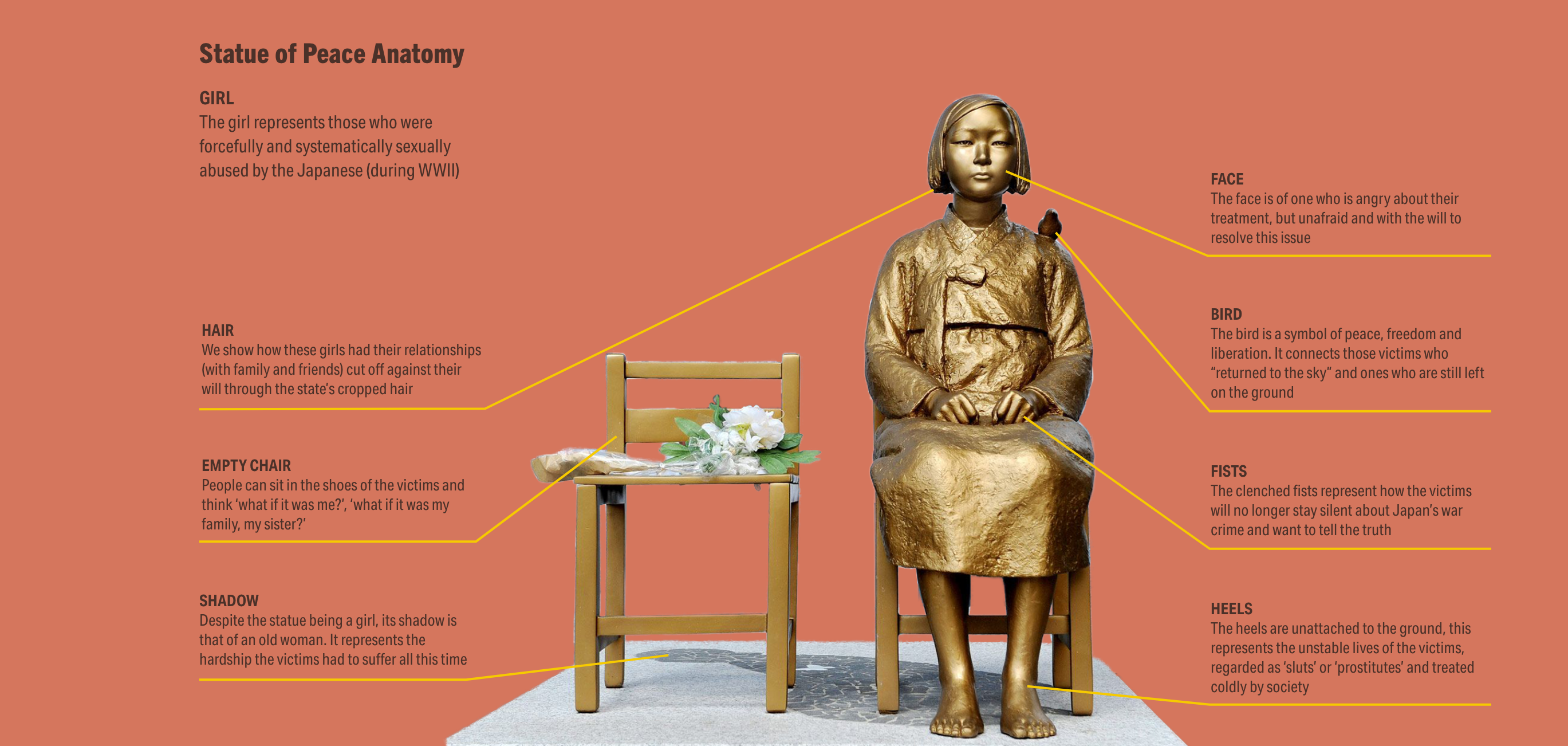
This was erected in 2011.
In late 2015, Japan stated that it would not pay 1 billion yen as compensation unless the statue was removed from its location in front of the Japanese embassy in Seoul. Eventually an agreement was reached. But a second statue was erected in Busan.
In June 2017, the civil congress of Busan, South Korea, made the legal foundation to protect the Statue of Peace by passing the relative ordinance. With this reason, it has become difficult to shift the site or demolish the statue.
In the gallery below indicates the 9 of the 23 memorials and museums dedicated to these women and the hardships they had gone through to be remembered.


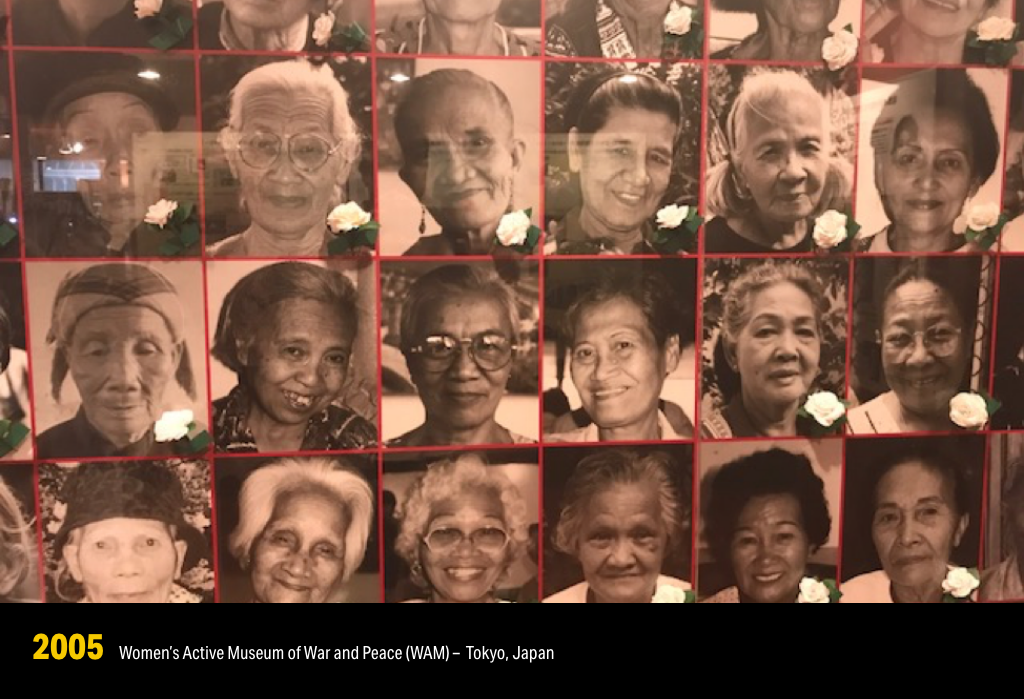




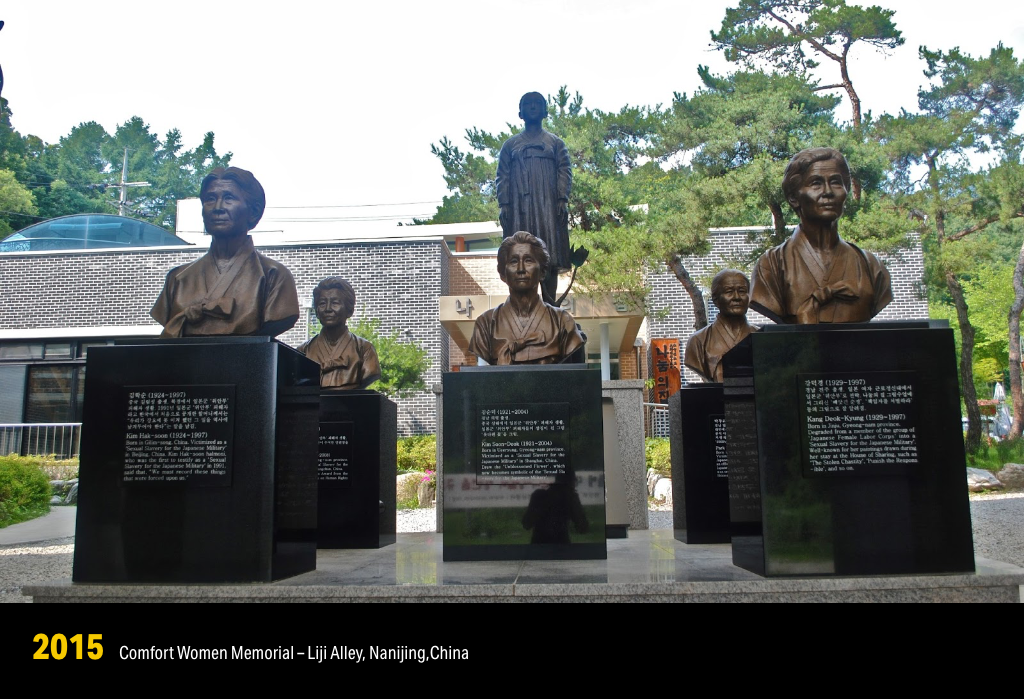

In recent decades, the matter of educating the next generation about Japan’s history and these women are still up for debate. The information about this history and history textbooks have soured relations between Japan and the two Koreas.
While in the Western nations, a much less controversial, less politicized and more study-oriented historiography thrived. In 2015, relations between the two nations reached a high point when South Korea and Japan addressed the issue of “comfort women”. Fumio Kishida, the Japanese Foreign Minister, pledged that the Japanese government would donate 1 billion yen ($8.3 million USD, 2015) to help pay for the care of the surviving former sex slaves. Furthermore, Japanese Prime Minister Shinzo Abe, made public apologies to the “women who underwent immeasurable and painful experiences and suffered insurable physical and psychological wounds as comfort women.” South Korean president, Park Geun-hye, without any communication with the alive “comfort women”, hailed this deal as a sign of positive progression in Japanese and South Korean relations.
In 2015, relations between the two nations reached a high point when South Korea and Japan addressed the issue of “comfort women”. Fumio Kishida, the Japanese Foreign Minister, pledged that the Japanese government would donate 1 billion yen ($8.3 million USD, 2015) to help pay for the care of the surviving former sex slaves. Furthermore, Japanese Prime Minister Shinzo Abe, made public apologies to the “women who underwent immeasurable and painful experiences and suffered insurable physical and psychological wounds as comfort women.”
By the end of 2015 Japan and South Korea have agreed to settle the issue of “comfort women”, in their first deal since 1965. South Korean President Park Geun-hye issued a statement, saying a deal has been urgently need–given the advanced age of most of the victims. “Nine died this year alone,” she said. “I hope the mental pains of the elders comfort women will be eased.”
The Japan-South Korean “Comfort Women” deal consisted the 1 billion yen to help fund the elderly comfort women still alive, which the South Korean government will administer. The money will come with an apology by Japan’s prime minister and the acceptance of “deep responsibility” for the issue. South Korea says it will consider the matter resolved “finally and irreversibly” if Japan fulfils it promises. South Korea will also look into removing a statue symbolizing “comfort women”, which activists erected outside the Japanese embassy in Seoul in 2011. Both sides have agreed to refrain from criticising each other on this issue in the international community.
The wording of the deal does not explicitly state that the “comfort women” will receive direct compensation. It’s unclear if Japan’s admission of responsibility was legal or just humanitarian. Some former “comfort women”, such as Lee Yong-soo, have taken issue with this. The 88 year-old said

Another former “comfort women”, 88-year-old Kim Hak-sun had said
The timing of the talks were highly symbolic and the expectations for results were high. Earlier that year, the South Korean President called for a resolution to the “comfort women” dispute by the year’s end, marking the 50th anniversary of diplomatic relations. With such a quick breakthrough, many believe that this could just be rushing to preserve the symbolism.
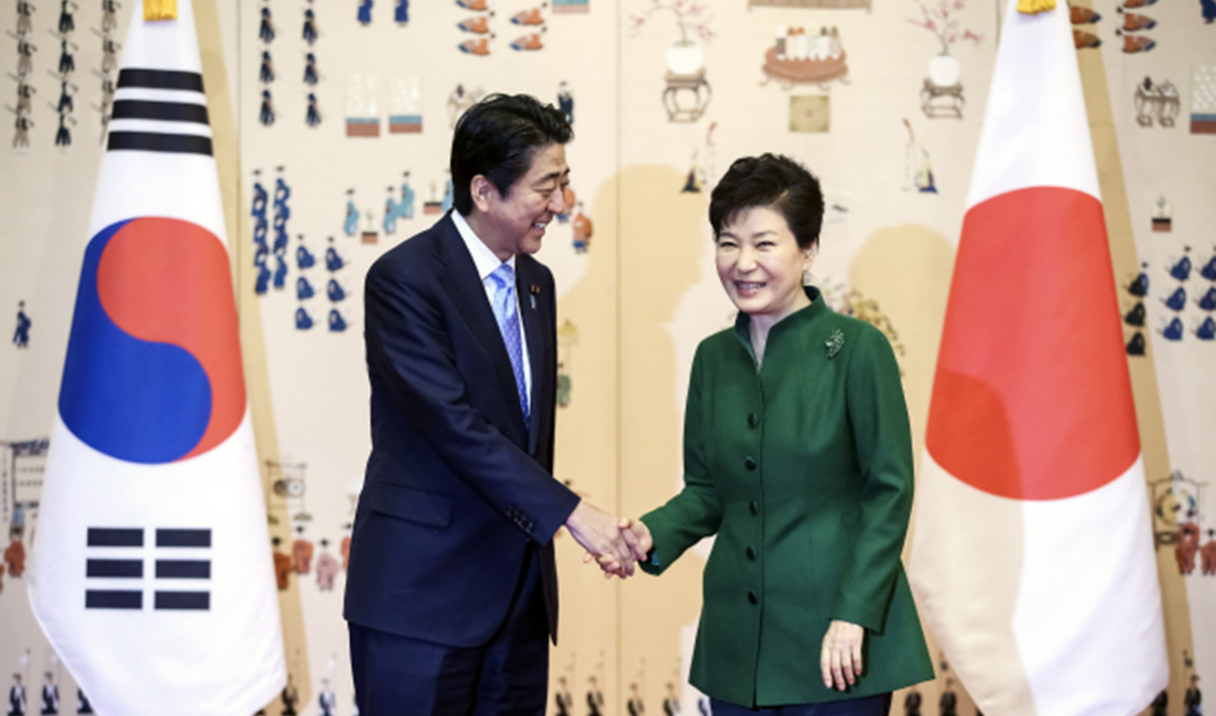
The civil society of South Korea thought that Park’s deal was selling out the dignity of survivors of wartime sexual slavery for short-term diplomatic and geopolitical gain. (A rising North Korean threat and mutual concern over China were factors that led to the agreement becoming the opportune in the first place.) As of 2015, only 46 former “comfort women” are still alive in South Korea.
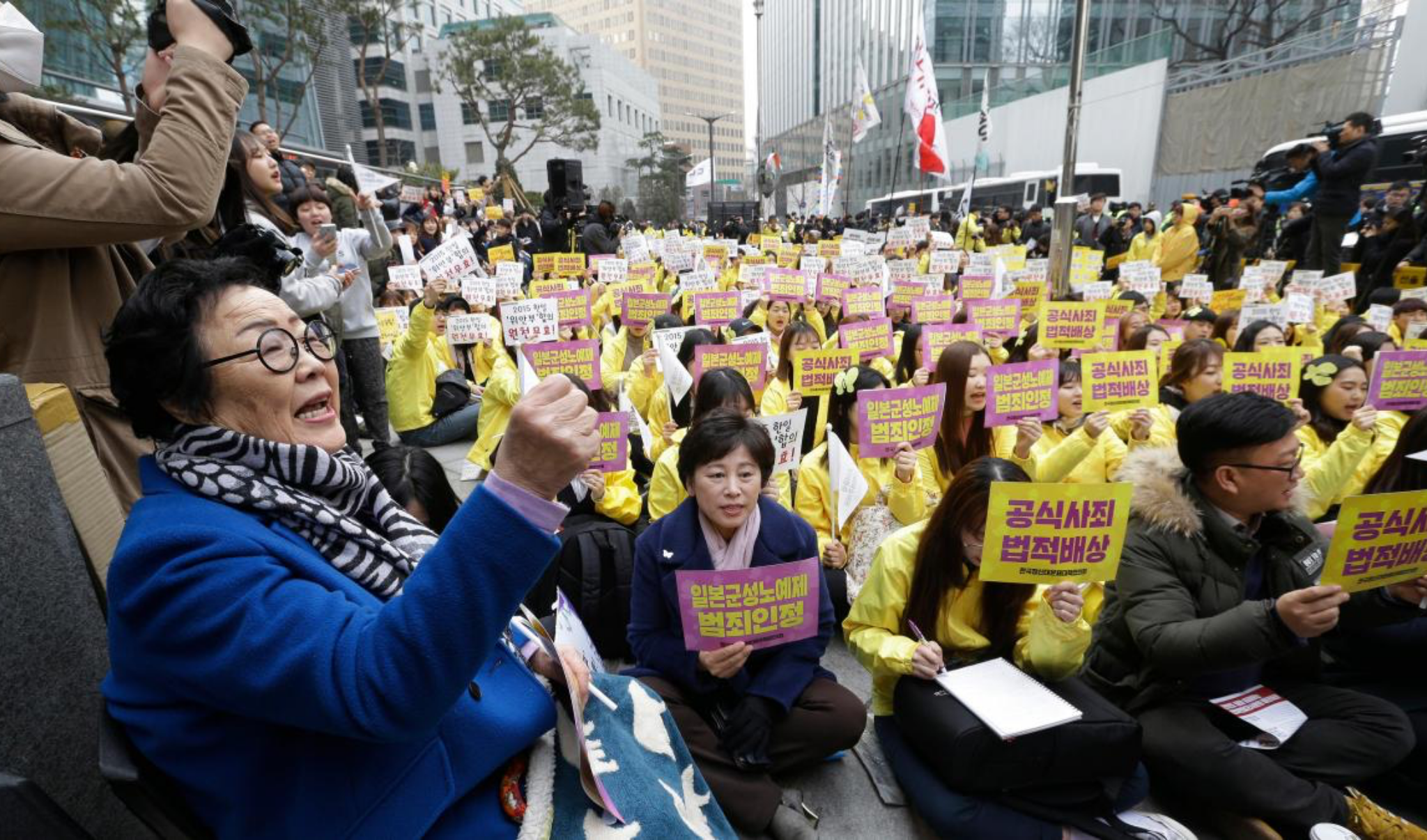
In 2015, there was a push in California, U.S. for the San Francisco statue was led by Chinese/Korean-American activists and was privately funded by the Comfort Women Justice Coalition in 2015, leading to its installation on September 22, 2017.
With the South Korea’s current President Jae-in Moon has disputed the 2015 “Comfort Women” Deal, signed by Park Geun-hye that was heralded as a final settlement for Korean women who were among many sexually enslaved in Japanese military brothels before and during World War II. Moon has called for a renegotiation of the pact.
In early 2017, the South Korean Foreign Ministry has sent an official letter to a district office in Busan asking that a contentious statue symbolizing the “comfort women” to be removed.


By June, the civil congress of Busan, South Korea, made the legal foundation to protect the Statue of Peace by passing the relative ordinance.
In 2018, the administration of Moon Jae-in to dredge up the issue of the “comfort women” that was purportedly resolved “finally and irreversibly” by the 2015 accord. A nationally televised news conference Wednesday, Moon backed Foreign Minister Kang Kyung-wha’s remarks, repeating that the agreement was reached in “the wrong way” because the victims were kept out of the loop, and demanding that Japan offer a “heartfelt apology,” according to South Korea’s Yonhap news agency.
Prime Minister Shinzo Abe, has repeated Tokyo’s traditional stance that the pact is a “government-to-government agreement” that should be upheld in accordance with “international and universal standards. That South Korea unilaterally requested additional measures is completely unacceptable,” adding Japan will continue to “firmly” urge South Korea to abide by the agreement. Various senior officials in Tokyo have pointed out since the collapse of the government led by Moon’s predecessor Park Geun&endash;hye that a change in leadership does not justify an unilateral abrogation of the deal.
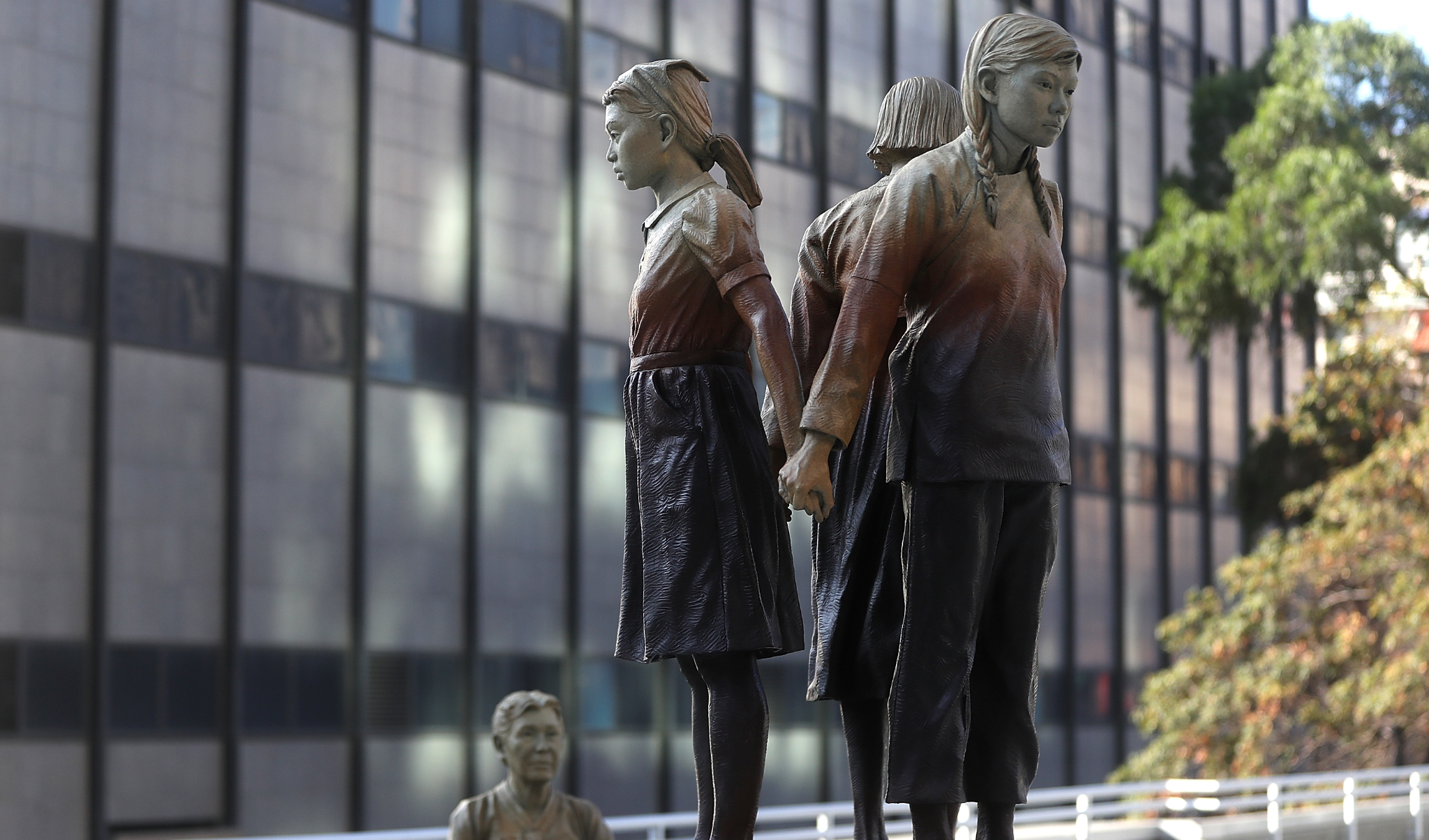
Osaka’s mayor, Hirofumi Yoshimura, terminated official ties this week after the US city agreed to recognize the “comfort women” statue, which was erected by a private group last year San Francisco’s Chinatown district, as public property. The statue depicts three women – from China, Korea and the Philippines – who symbolize women and teenage girls forced to work under Imperial Japan.
The numbers of “comfort women” are dwindling due to their old age and their health complications that were caused by all the abuse they had gone through much earlier in their life.
With the numbers of “comfort women” drastically dropping, there’s a level of urgency of promoting for these women to find the peace they deserve to people waiting for the clock to be up, and finally settle a deal about these women and their history. On November 21, 2018, South Korea terminates the 2015 agreement and effectively shut down the Japanese-funded “comfort women” foundation which was set up to pay the agreed settlement. ∎